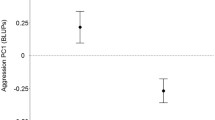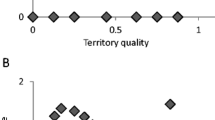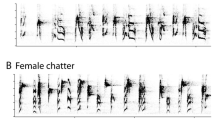Abstract
In a variety of taxa, male reproductive success is positively related to the expression of costly traits such as large body size, ornaments, armaments, and aggression. These traits are thought to improve male competitive ability and, thus, access to limited reproductive resources. Females of many species also express competitive traits. However, we know very little about the consequences of individual variation in competitive traits and the mechanisms that regulate their expression in females. Consequently, it is currently unclear whether females express competitive traits owing to direct selection or as an indirect result of selection on males. Here, we examine females of a mildly dimorphic songbird (Junco hyemalis) to determine whether females show positive covariance in traits (morphology and behavior) that may be important in a competition. We also examine whether trait expression relates either to testosterone (T) in terms of mechanism or to reproductive success in terms of function. We found that larger females were more aggressive and that greater ability to produce T in response to a physiological challenge consisting of a standardized injection of gonadotropin-releasing hormone predicted some measures of female body size and aggression. Finally, we found that aggressive females had greater reproductive success. We conclude that T may influence female phenotype and that females may benefit from expressing a competitive phenotype. We also suggest that the mild dimorphism observed in many species may be due in part to direct selection on females rather than simply a correlated response to selection in males.



Similar content being viewed by others
References
Abrams P, Matsuda H (1994) The evolution of traits that determine ability in competitive contests. Evol Ecol 8:667–686
Adkins-Regan E (2005) Hormones and animal social behavior. Princeton University Press, Princeton
Amundsen T (2000) Why are female birds ornamented? Trends Ecol Evol 15:149–155
Amundsen T, Forsgren E, Hansen L (1997) On the function of female ornaments: male bluethroats prefer colourful females. Proc R Soc Lond B 264:1579–1586
Andersson M (1994) Sexual selection. Princeton University Press, Princeton
Arnold S, Wade M (1984a) On the measurement of natural and sexual selection: applications. Evolution 38:720–734
Arnold S, Wade M (1984b) On the measurement of natural and sexual selection: theory. Evolution 38:709–719
Badyaev AV (2002) Growing apart: an ontogenetic perspective on the evolution of sexual size dimorphism. Trends Ecol Evol 17:369–378
Badyaev AV, Martin TE (2000) Sexual dimorphism in relation to current selection in the house finch. Evolution 54:987–997
Balthazart J, Ball GF (1995) Sexual differentiation of brain and behavior in birds. Trends Endocr Met 6:21–29
Beehner J, Phillips-Conroy J, Whitten P (2005) Female testosterone, dominance rank, and aggression in an Ethiopian population of hybrid baboons. Am J Primatol 67:101–119
Blanckenhorn W (2005) Behavioral causes and consequences of sexual size dimorphism. Ethology 111:977–1016
Box G (1962) Robustness to non-normality of regression tests. Biometrika 49:93–106
Brodie ED III, Moore AJ, Janzen FJ (1995) Visualizing and quantifying natural selection. Trends Ecol Evol 10:313–318
Cain KE, Rich M, Ainsworth K, Ketterson ED (2011) Two sides of the same coin? Consistency in aggression to conspecifics and predators in a female songbird. Ethology 117:786–795
Cawthorn JM, Morris DL, Ketterson ED, Nolan V Jr (1998) Influence of experimentally elevated testosterone on nest defence in dark-eyed juncos. Anim Behav 56:617–621
Chenoweth S, Rundle H, Blows M (2008) Genetic constraints and the evolution of display trait sexual dimorphism by natural and sexual selection. Am Nat 171:22–34
Clotfelter ED, O’Neal DM, Gaudioso JM, Casto JM, Parker-Renga IM, Snajdr EA, Duffy DL, Nolan V Jr, Ketterson ED (2004) Consequences of elevating plasma testosterone in females of a socially monogamous songbird: evidence of constraints on male evolution? Horm Behav 46:171–178
Clotfelter ED, Pedersen AB, Cranford JA, Ram N, Snajdr EA, Nolan V Jr, Ketterson ED (2007) Acorn mast drives long-term dynamics of rodent and songbird populations. Oecologia 154:493–503
Clutton-Brock T (2009) Sexual selection in females. Anim Behav 77:3–11
Cox R, Calsbeek R (2009) Sexually antagonistic selection, sexual dimorphism, and the resolution of intralocus sexual conflict. Am Nat 173:176–187
Cox R, Stenquist D, Calsbeek R (2009) Testosterone, growth and the evolution of sexual size dimorphism. J Evol Biol 22:1586–1598
Cristol DA, Johnsen TS (1994) Spring arrival, aggression and testosterone in female red-winged blackbirds (Agelaius phoeniceus). Auk 111:210–214
Cuervo J, de Lope F, Møller A (1996) The function of long tails in female barn swallows (Hirundo rustica): an experimental study. Behav Ecol 7:132
Duckworth R (2006) Behavioral correlations across breeding contexts provide a mechanism for a cost of aggression. Behav Ecol 17:1011
Dufty AM, Clobert J, Møller AP (2002) Hormones, developmental plasticity and adaptation. Trends Ecol Evol 17:190–196
Elekonich M (2000) Female song sparrow, Melospiza melodia, response to simulated conspecific and heterospecific intrusion across three seasons. Anim Behav 59:551–557
Fairbairn D, Blanckenhorn W, Szekely T (2007) Sex, size and gender roles: evolutionary studies of sexual size dimorphism. Oxford University Press, New York
Finch CE, Rose MR (1995) Hormones and the physiological architecture of life history evolution. Q Rev Biol 70:1–52
Forsgren E, Amundsen T, Borg ÅA, Bjelvenmark J (2004) Unusually dynamic sex roles in a fish. Nature 429:551–554
Fretwell S (1969) Dominance behavior and winter habitat distribution in juncos (Junco hyemalis). Bird Band 40:1–25
Goymann W, Wittenzellner A, Schwabl I, Makomba M (2008) Progesterone modulates aggression in sex-role reversed female African black coucals. Proc R Soc Lond B 275:1053–1060
Grubb TC (1989) Ptilochronology: feather growth bars as indicators of nutritional status. Auk 106:314–320
Hau M (2000) Testosterone and year-round territorial aggression in a tropical bird. Gen Comp Endocrinol 117:20–33
Hau M (2007) Regulation of male traits by testosterone: implications for the evolution of vertebrate life histories. Bioessays 29:133–144
Illes AE, Yunes-Jimenez L (2009) A female songbird out-sings male conspecifics during simulated territorial intrusions. Proc R Soc Lond B 276:981–986
Jawor J, Gray N, Beall S, Breitwisch R (2004) Multiple ornaments correlate with aspects of condition and behaviour in female northern cardinals, Cardinalis cardinalis. Anim Behav 67:875–882
Jawor JM, McGlothlin JW, Casto JM, Greives TJ, Snajdr EA, Bentley GE, Ketterson ED (2006a) Seasonal and individual variation in response to GnRH challenge in male dark-eyed juncos (Junco hyemalis). Gen Comp Endocrinol 149:182–189
Jawor J, Young R, Ketterson ED (2006b) Females competing to reproduce: dominance matters but testosterone may not. Horm Behav 49:362–368
Jawor J, McGlothlin J, Casto JM, Greives TJ, Snajdr EA, Bentley GE, Ketterson ED (2007) Testosterone response to GnRH in a female songbird varies with stage of reproduction: implications for adult behavior and maternal effects. Funct Ecol 21:767–775
Johnson A (2000) Reproduction in the female. Sturkie’s Avian Physiol 5:569–596
Kempenaers B, Peters A, Foerster K (2008) Sources of individual variation in plasma testosterone levels. Phil Trans R Soc Lond B Biol Sci 363:1711–1723
Ketterson ED (1979) Status signaling in dark-eyed juncos. Auk 96:94–99
Ketterson ED (1992) Testosterone and avian life histories: effects of experimentally elevated testosterone on behavior and correlates of fitness in the dark-eyed junco (Junco hyemalis). Am Nat 140:980–999
Ketterson ED, Nolan V Jr (1999) Adaptation, exaptation, and constraint: a hormonal perspective. Am Nat 154:4–25
Ketterson ED, Nolan V Jr, Wolf L, Ziegenfus C, Dufty AM, Ball GF, Johnsen TS (1991) Testosterone and avian life histories: the effect of experimentally elevated testosterone on corticosterone and body mass in dark-eyed juncos. Horm Behav 25:489–503
Ketterson ED, Nolan V Jr, Sandell M (2005) Testosterone in females: mediator of adaptive traits, constraint on sexual dimorphism, or both? Am Nat 166(Suppl 4):S85–S98
Ketterson ED, Atwell J, McGlothlin JW (2009) Phenotypic integration and independence: hormones, performance, and response to environmental change. Integr Comp Biol 49:365–379
Kotaiho S (2001) Costs of sexual traits: a mismatch between theoretical considerations and empirical evidence. Biol Rev Camb Philos Soc 76:365–376
Lande R (1980) Sexual dimorphism, sexual selection, and adaptation in polygenic characters. Evolution 34:292–305
Lande R, Arnold SJ (1983) The measurement of selection on correlated characters. Evolution 37:1210–1226
Langmore NE, Cockrem JF, Candy EJ (2002) Competition for male reproductive investment elevates testosterone levels in female dunnocks, Prunella modularis. Proc R Soc Lond B 269:2473–2478
Langston N, Freeman S, Rohwer S, Gori D (1990) The evolution of female body size in red-winged blackbirds: the effects of timing of breeding, social competition, and reproductive energetics. Evolution 44:1764–1779
LeBas N (2006) Female finery is not for males. Trends Ecol Evol 21:170–173
Lindström A, Visser GH, Daan S (1993) The energetic cost of feather synthesis is proportional to basal metabolic rate. Physiol Zool 66:490–510
Lynn SE, Hayward LS, Benowitz-Fredericks ZM, Wingfield JC (2002) Behavioural insensitivity to supplementary testosterone during the parental phase in the chestnut-collared longspur, Calcarius ornatus. Anim Behav 63:795–803
Lynn SE, Walker BG, Wingfield JC (2005) A phylogenetically controlled test of hypotheses for behavioral insensitivity to testosterone in birds. Horm Behav 47:170–177
Mank JE (2007) The evolution of sexually selected traits and antagonistic androgen expression in actinopterygiian fishes. Am Nat 169:142–149
Marra PP (2000) The role of behavioral dominance in structuring patterns of habitat occupancy in a migrant bird during the nonbreeding season. Behav Ecol 11:299–308
McGlothlin JW, Ketterson ED (2008) Hormone-mediated suites as adaptations and evolutionary constraints. Philos Trans R Soc Lond B Biol Sci 363:1611–1621
McGlothlin JW, Parker PG, Nolan V Jr, Ketterson ED (2005) Correlational selection leads to genetic integration of body size and an attractive plumage trait in dark-eyed juncos. Evolution 59:658–671
McGlothlin JW, Duffy DL, Henry-Freeman JL, Ketterson ED (2007a) Diet quality affects an attractive white plumage pattern in dark-eyed juncos (Junco hyemalis). Behav Ecol Sociobiol 61:1391–1399
McGlothlin JW, Jawor JM, Ketterson ED (2007b) Natural variation in a testosterone-mediated trade-off between mating effort and parental effort. Am Nat 170:864–875
McGlothlin JW, Jawor JM, Greives TJ, Casto JM, Phillips JL, Ketterson ED (2008) Hormones and honest signals: males with larger ornaments elevate testosterone more when challenged. J Evol Biol 21:39–48
McGlothlin JW, Whittaker DJ, Schrock SE, Gerlach NM, Jawor JM, Snajdr EA, Ketterson ED (2010) Natural selection on testosterone production in a wild songbird population. Am Nat 175:687–701
Møller A (1993) Sexual selection in the barn swallow Hirundo rustica. III. Female tail ornaments. Evolution 47:417–431
Moore IT, Perfito N, Wada H, Sperry TS, Wingfield JC (2002) Latitudinal variation in plasma testosterone levels in birds of the genus Zonotrichia. Gen Comp Endocrinol 129:13–19
Murphy TG, Rosenthal MF, Montgomerie R, Tarvin KA (2009) Female American goldfinches use carotenoid-based bill coloration to signal status. Behav Ecol 20:1348–1355. doi:10.1093/beheco/arp140
Nespor AA, Lukazewicz MJ, Dooling RJ, Ball GF (1996) Testosterone induction of male-like vocalizations in female budgerigars (Melopsittacus undulatus). Horm Behav 30:162–169
Nolan V Jr, Ketterson ED, Cristol DA, Rogers CM, Clotfeller ED, Titus RC, Schoech SJ, Snajdr EA (2002) Dark-eyed junco (Junco hyemalis). No. 716. In: Poole A, Gill F (eds) The birds of North America. The Birds of North America, Inc., Philadelphia
O’Neal DM, Reichard DG, Pavilis K, Ketterson ED (2008) Experimentally-elevated testosterone, female parental care, and reproductive success in a songbird, the dark-eyed Junco (Junco hyemalis). Horm Behav 54:571–578
Owens I, Hartley I (1998) Sexual dimorphism in birds: why are there so many different forms of dimorphism? Proc R Soc Lond B 265:397–407
Packer C, Collins D, Sindimwo A, Goodall J (1995) Reproductive constraints on aggressive competition in female baboons. Obstet Gynecol Surv 50:449
Pärn H, Lindström KM, Sandell M, Amundsen T (2008) Female aggressive response and hormonal correlates—an intrusion experiment in a free-living passerine. Behav Ecol Sociobiol 62:1665–1677
Peters A (2000) Testosterone treatment is immunosuppressive in superb fairy-wrens, yet free-living males with high testosterone are more immunocompetent. Proc R Soc Lond B 267:883–889. doi:10.1098/rspb.2000.1085
Raouf SA, Parker PG, Ketterson ED, Nolan V Jr, Ziegenfus C (1997) Testosterone affects reproductive success by influencing extra-pair fertilizations in male dark-eyed juncos (Aves: Junco hyemalis). Proc R Soc Lond B 264:1599–1603
Reed WL, Clark ME, Parker PG, Raouf SA, Arguedas N, Monk DS, Snajdr EA, Nolan V Jr, Ketterson ED (2006) Physiological effects on demography: a long-term experimental study of testosterone’s effects on fitness. Am Nat 167:667–683
Rhen T, Ross J, Crews D (1999) Effects of testosterone on sexual behavior and morphology in adult female leopard geckos, Eublepharis macularius. Horm Behav 36:119–128
Robinson MR, Kruuk LEB (2007) Function of weaponry in females: the use of horns in intrasexual competition for resources in female Soay sheep. Biol Lett 3:651–654
Rosvall KA (2008) Sexual selection on aggressiveness in females: evidence from an experimental test with tree swallows. Anim Behav 75:1603–1610
Rosvall KA (2011a) Intrasexual competition in females: evidence for sexual selection? Behav Ecol. doi:10.1093/beheco/arr106
Rosvall KA (2011b) Maintenance of variation in sexually selected traits in females: a case study using intrasexual aggression in tree swallows Tachycineta bicolor. J Avian Biol. doi:10.1111/j.1600-048X.2011.05322.x
Rosvall KA (2011c) Cost of female intrasexual aggression in terms of offspring quality: a cross-fostering study. Ethology 117:1–13
Sall J (1990) Leverage plots for general linear hypotheses. Am Stat 44:308–315
Sandell MI (1998) Female aggression and the maintenance of monogamy: female behaviour predicts male mating status in European starlings. Proc R Soc Lond B 265:1307–1311
Sandell MI (2007) Exogenous testosterone increases female aggression in the European starling (Sturnus vulgaris). Behav Ecol Sociobiol 62:255–262. doi:10.1007/s00265-007-0460-9
Schuett W, Tregenza T, Dall SRX (2010) Sexual selection and animal personality. Biol Rev Camb Philos Soc 85:217–246. doi:10.1111/j.1469-185X.2009.00101.x
Shuster SM, Wade MJ (2003) Mating systems and strategies. Princeton University Press, Princeton
Sinn D, While G, Wapstra E (2008) Maternal care in a social lizard: links between female aggression and offspring fitness. Anim Behav 76:1249–1257
Slagsvold T, Amundsen T, Dale S, Lampe H (1992) Female–female aggression explains polyterritoriality in male pied flycatchers. Anim Behav 43:397–407
Smith RD, Metcalfe NB (1997) Why does dominance decline with age in wintering snow buntings? Anim Behav 53:313–322
Staub NL, De Beer M (1997) The role of androgens in female vertebrates. Gen Comp Endocrinol 108:1–24
Stinchcombe JR, Agrawal AF, Hohenlohe PA, Arnold SJ, Blows MW (2008) Estimating nonlinear selection gradients using quadratic regression coefficients: double or nothing? Evolution 62:2435–2440
Thomas L, Krebs CJ (2003) A review of statistical power analysis software. Bull Ecol Soc Am 78:128–139
Van Duyse E, Pinxten R, Darras VM, Arckens L, Eens M (2004) Opposite changes in plasma testosterone and corticosterone levels following a simulated territorial challenge in male great tits. Behaviour 141:451–467
Veiga JP, Viñuela J, Cordero PJ, Aparicio JM, Polo V (2004) Experimentally increased testosterone affects social rank and primary sex ratio in the spotless starling. Horm Behav 46:47–53
Watson N, Simmons L (2010) Reproductive competition promotes the evolution of female weaponry. Proc R Soc Lond B 277:2035–2040
Wauters LA (1995) Lifetime reproductive success and its correlates in female Eurasian red squirrels. Oikos 72:402–410
Weiss S (2006) Female-specific color is a signal of quality in the striped plateau lizard (Sceloporus virgatus). Behav Ecol 17:726
West-Eberhard MJ (1983) Sexual selection, social competition, and speciation. Q Rev Biol 58:55–183
While G, Isaksson C, McEvoy J, Sinn D, Komdeur J, Wapstra E, Groothuis T (2010) Repeatable intra-individual variation in plasma testosterone concentration and its sex-specific link to aggression in a social lizard. Horm Behav 58:208–213
Williams TD (2008) Individual variation in endocrine systems: moving beyond the ‘tyranny of the Golden Mean’. Philos Trans R Soc B 363:1687–1698
Wingfield JC, Farner DS (1975) The determination of five steroids in avian plasma by radioimmunoassay and competitive protein-binding. Steroids 26:311–327
Wingfield JC, Matt KS, Farner DS (1984) Physiologic properties of steroid hormone-binding proteins in avian blood. Gen Comp Endocrinol 53:281–292
Wingfield JC, Ball GF, Dufty AM, Hegner RE, Ramenofsky M (1987) Testosterone and aggression in birds. Am Sci 75:602–608
Wingfield JC, Hegner R, Lewis D (1991) Circulating levels of luteinizing hormone and steroid hormones in relation to social status in the cooperatively breeding white browed sparrow weaver, Plocepasser mahali. J Zool 225:43–58
Wingfield JC, Lynn SE, Soma KK (2001) Avoiding the ‘costs’ of testosterone: ecological bases of hormone-behavior interactions. Brain Behav Evol 57:239–251
Wolf WL, Casto JM, Nolan V Jr, Ketterson ED (2004) Female ornamentation and male mate choice in dark-eyed juncos. Anim Behav 67:93–102
Yasukawa K, Searcy WA (1982) Aggression in female red-winged blackbirds: a strategy to ensure male parental investment. Behav Ecol Sociobiol 11:13–17
Zysling DA, Greives TJ, Breuner CW, Casto JM, Demas GE, Ketterson ED (2006) Behavioral and physiological responses to experimentally elevated testosterone in female dark-eyed juncos (Junco hyemalis carolinensis). Horm Behav 50:200–207
Acknowledgments
This research adhered to the Association for the Study of Animal Behavior/Animal Behavior Society Guidelines for the Use of Animals in Research, the legal requirements of the United States of America (USFWS special use permit number MB093279-2, USGS banding permit number 20261), the States of Indiana and Virginia, and was conducted in compliance with the University of Virginia and Indiana University Institutional Animal Care and Use Committee (protocol # 06-242). The authors thank the Ketterson Lab, particularly K. Rosvall, for the assistance in developing the methods, discussion, and comments on the manuscript; A. Dapper and S. Wanamaker and the United Junco Workers for the field assistance; S. Hoobler for the additional support; and Mountain Lake Biological Station (B. Brodie III, Director and E. Nagy, Associate Director) and Mountain Lake Hotel for the facilities and permission to work on their property. Research was supported by National Science Foundation (NSF) grants to EK (BSC 05-19211 and IOS 08-20055) and an NSF Doctoral Dissertation Improvement Grant to KC (0910036). KC was also supported by an NSF Graduate Research Fellowships Program fellowship and National Institute of Health training grant, Common Themes in Reproductive Diversity (NIH no. HD 049336-04).
Author information
Authors and Affiliations
Corresponding author
Additional information
Communicated by J. Graves
Rights and permissions
About this article
Cite this article
Cain, K.E., Ketterson, E.D. Competitive females are successful females; phenotype, mechanism, and selection in a common songbird. Behav Ecol Sociobiol 66, 241–252 (2012). https://doi.org/10.1007/s00265-011-1272-5
Received:
Revised:
Accepted:
Published:
Issue Date:
DOI: https://doi.org/10.1007/s00265-011-1272-5




